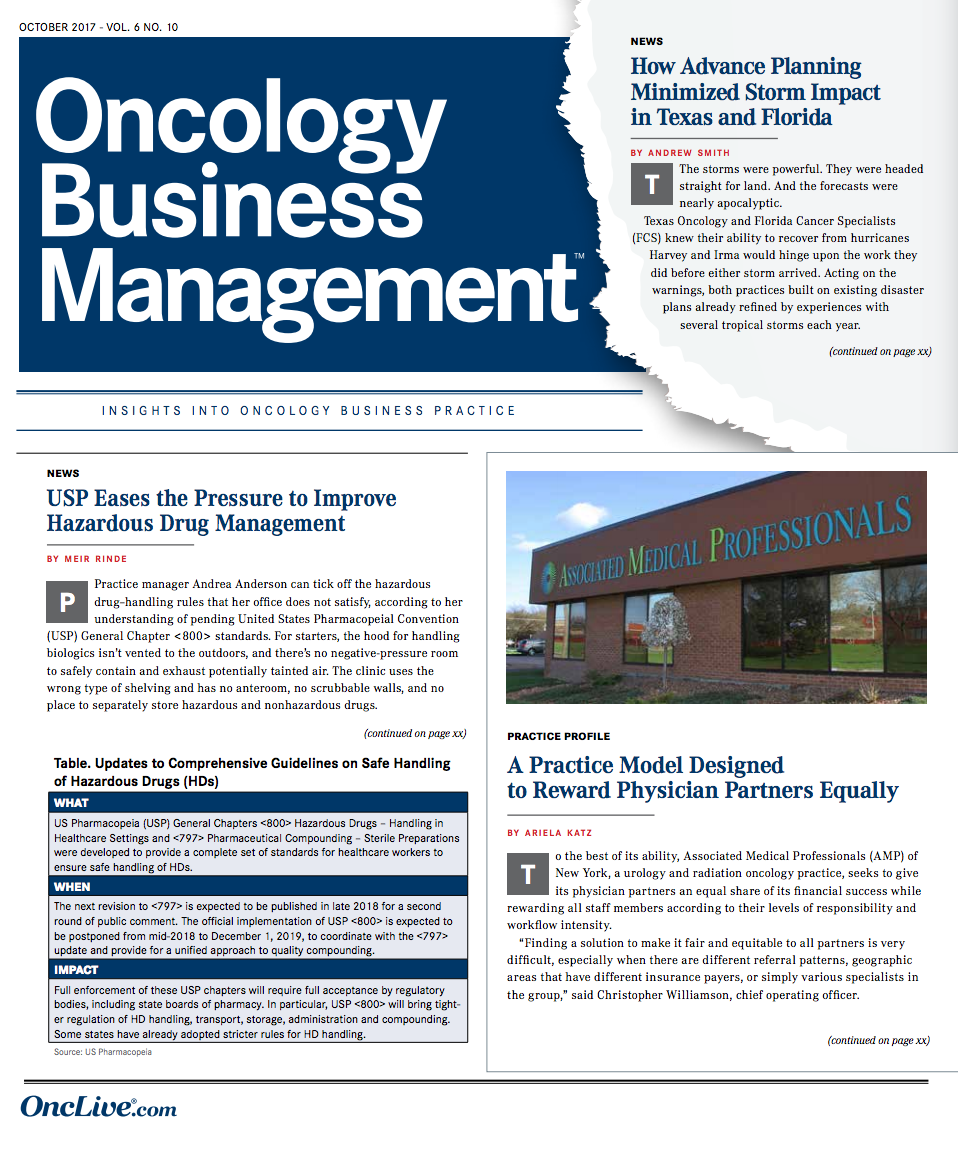Publication
Article
Special Issues
Proving That Value-Based Care Is Possible
Author(s):
More than 2 years after the passage of the Medicare Access and CHIP Reauthorization Act of 2015, the progression toward value-based care has challenged oncologists to assume an unprecedented degree of accountability for the well-being and holistic care of their patients.
Barbara L. McAneny, MD
More than 2 years after the passage of the Medicare Access and CHIP Reauthorization Act of 2015 (MACRA), the progression toward valuebased care has challenged oncologists to assume an unprecedented degree of accountability for the well-being and holistic care of their patients. Those practices participating in the Oncology Care Model (OCM), with its extensive practice transformation requirements, got a head start. Now the Meritbased Incentive Payment System (MIPS) compels many more to evaluate their clinical, financial, and administrative readiness for these new reimbursement models. What will determine success? The ability of practices to increase control over the drivers that affect quality and costs of care—across all patient conditions and settings of care.
Fortunately, efforts to achieve the highest-quality cancer care in a cost-efficient manner have been many years in the making, with results that can guide practices on their value-based care journey. Such is the case with Innovative Oncology Business Solutions (IOBS), which received a $19.8 million award in June 2012 from the Center for Medicare & Medicaid Innovation to develop and test a new community oncology medical home (COME HOME) model.
The COME HOME program engaged 7 practices across the country in service of a goal at the heart of value-based care: improve the quality and experience of patient care while bringing down its overall cost. Our approach was to advance integrated, coordinated care to patients with cancer through triage pathways, enhanced access, and treatment pathways. To achieve the greatest benefit for patients and practices alike, COME HOME specifically targeted unnecessary and costly inpatient hospital admissions, visits to emergency departments (EDs), and readmissions.
Participating practices mobilized enhanced services including patient education and medication management counseling; team care; 24/7 practice access (telephone triage, night/weekend clinic hours, and on-call oncologists); on-site or near-site imaging and laboratory testing; and admitting physicians who shepherd patients through inpatient encounters, avoiding handoffs and inpatient admissions, to ensure seamless, safe, and efficient care. In the 3-year course of the program, compelling results included:
- A decrease of 7.2% in the overall cost of care
- Declines in inpatient hospital admissions (12.5%), 30-day hospital readmissions (11.7%), and ED visits (6.6%)
- Improvements in quality of life and quality of care for patients Although the potential of COME HOME was not always easy for the participating practices, the lessons learned provide a road map for success with value-based reimbursement models, including:
- Focus on high-risk patients as they reach critical decision points. For our practices, patients amid specific treatments are those at greatest risk for adverse events such as nausea and pain that, if not addressed in a timely and compassionate manner, can quickly escalate.
- Prioritize avoidance of the highest-cost events. COME HOME focused on the drivers of greatest avoidable cost and major sources of distress for patients: unnecessary inpatient admissions, ED visits, and readmissions.
- Recognize that practice transformation is necessary to optimize results. COME HOME practices were led by committed leadership willing to enact cultural change in support of more holistic patient support and then back that up with staffing and workflow models to enhance triage capabilities across all care settings.
With the conclusion of the COME HOME program, IOBS has focused on broadening access of COME HOME resources for the entire oncology community now embracing value-based care through MIPS and the OCM. One important milestone was our collaboration with ASCO to replicate and expand our tools across the United States. This partnership was launched in November 2016.
Advances in technology have also created new opportunities to amplify the impact of COME HOME’s efforts. In August, we announced a partnership with Integra Connect, which provides innovative technologies and services to leading oncology practices as they transition to value-based care. Together, we will embed COME HOME protocols in Integra Connect’s OCM and population health solutions so practice staff can provide aggressive symptom management as part of their patient triage and care coordination workflows and then track and report on results through advanced analytics. Triage activities enabled through Integra Connect’s solutions will focus on first responders (phone operators) and nurses, who will be guided through step-by-step clinical decision making as they discuss and assess a wide variety of patient issues such as pain, nausea, and vomiting. The technology will afford an unprecedented ability to incorporate and integrate COME HOME’s best practices in the daily operations of a practice.
As oncologists grapple with the new realities of value-based care, it is useful to remember that the charge toward increasing the quality of outcomes in the most cost-efficient manner did not start with MACRA. There are lessons, backed up by decisive data, that can guide practices in their efforts: target the highest-risk patients; enable accessible, team-based care; and confront issues head-on before they escalate into unnecessary use of high-cost settings. Resources such as those from the COME HOME program, amplified and extended by the latest technologies, mean that tools at oncology’s disposal are more robust than ever. All things considered, the conclusion is a heartening one: Practices will do best by new reimbursement models when they do well by both their patients and the greater system of care upon which we all rely.









